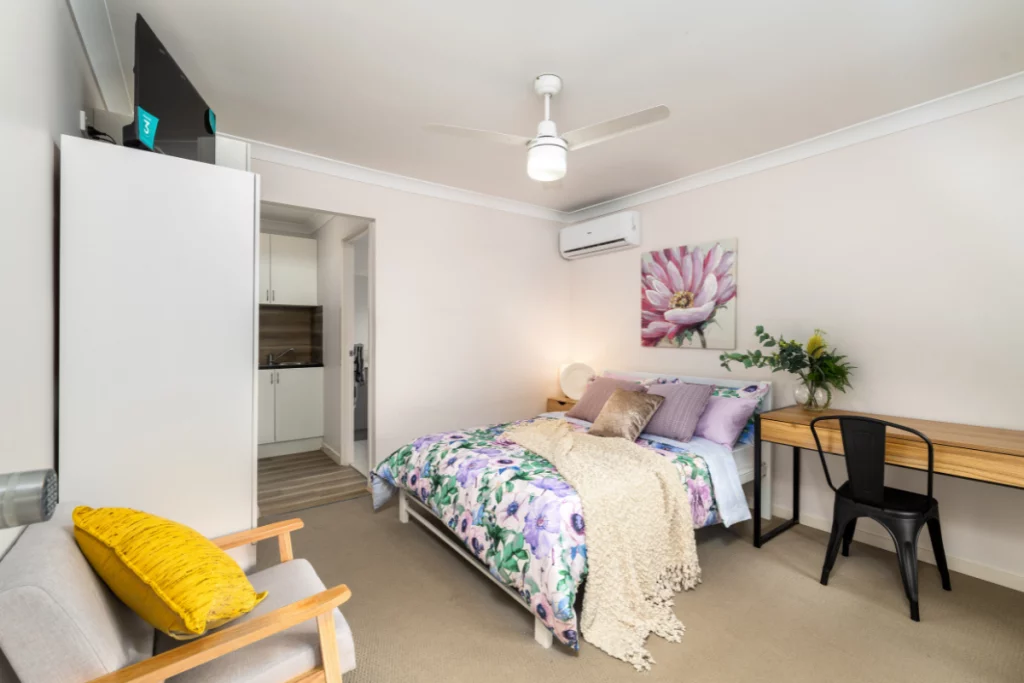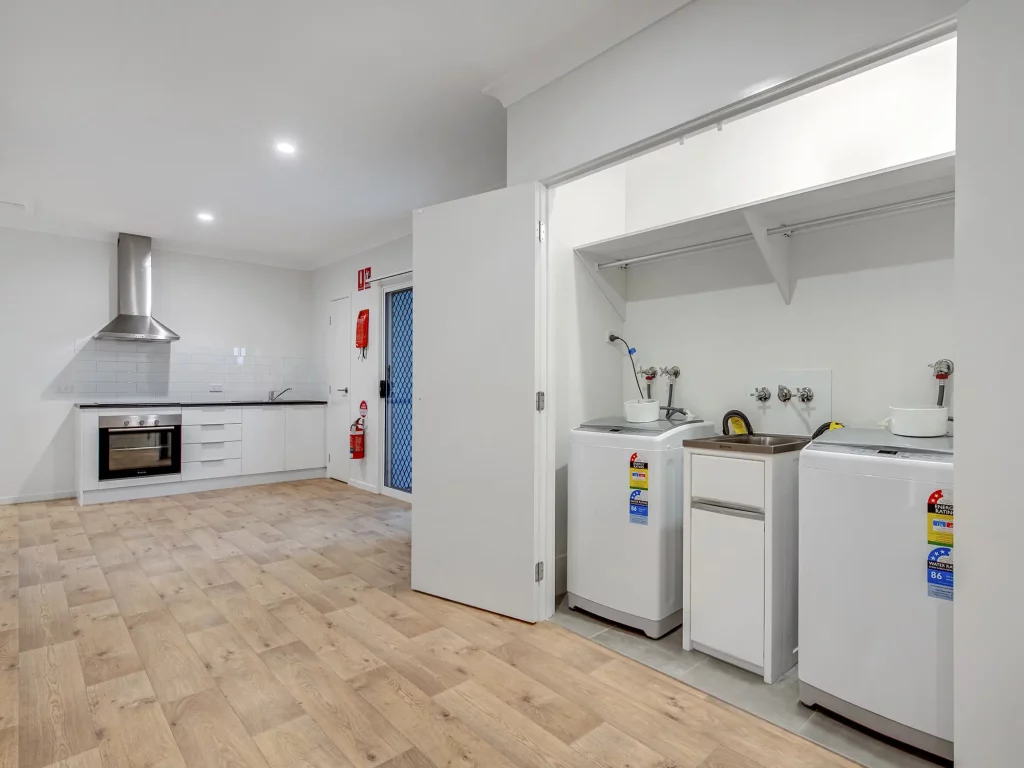As a way to live affordably and securely, with privacy when you want it and all your bills bundled into one weekly payment, co-living can be a godsend. Especially in difficult rental markets like Queensland.
29-year-old teacher Felicity has been ensconced in her studio flat since January 2020. It’s an upstairs room in a former three-bedroom townhouse that’s been converted into co-living micro-apartments.
Moving to Queensland from the UK in 2019, Felicity had landed originally on the Sunshine Coast. After struggling to find a teaching position, she answered an ad for a job in a Gold Coast school. And from there it all fell into place.
Her micro-apartment is close to work with its own bathroom and kitchenette. “I really like my apartment. I’ve got everything I need,” Felicity says. But not everyone is so lucky. She says the Gold Coast rental market has gone “insane” since she’s lived there.
SCROLL DOWN to see how Co-living is helping solve the affordable housing crisis

A solution to the housing crisis
“Some of my work colleagues have had to apply for up to 40 different places,” Felicity says. “They keep getting outbid by other people. So having something secure like this is great for me.”
Felicity has befriended her downstairs neighbours who are also British, and they help each other out, bringing in each other’s deliveries and checking in occasionally. “With no family here, and especially when I first moved in, it was good to know I could have gone to them for help. I definitely feel safe here,” she says.
But she’s the first to admit that before she lived in one, she hadn’t heard of micro-apartments or HMOs, ‘houses in multiple occupation’. Now she enjoys the convenience of one weekly payment of $275 a week covering all her bills, from energy to internet.
“For someone like me, being new to Australia, I didn’t know the best internet company or electricity company, so having that already sorted out was ideal.” she says.

Bills in one bundle a plus for many
Co-living residents Virginia and Troy also appreciate not having to worry about multiple bills at home. They run a restaurant on the Sunshine Coast, so they’re already juggling invoices and responsibilities in every aspect of their business.
“We pay one bill of $340 a week for the apartment. It direct debits out of our bank account, so we never have to think about when the internet or electricity bills are coming in.” Virginia says. “Someone mows the lawn, and a cleaner comes to do the common areas.”
Virginia and Troy’s studio is part of a two-storey house, now comprising four individual micro-apartments with a separate granny flat. It’s a handy three-minute drive from the restaurant.
“All the apartments are very different,” Virginia says. Theirs has big windows looking out onto trees, which they love.
“We’re locked up in the restaurant so often, to come home and feel like we’re in nature is amazing. Being off the street at the end of a battle-axe block, you feel like you could be anywhere.”
Sliding doors close off the sunroom when they want to shut out the light or cool the apartment down. And they’re quite satisfied with their tidy kitchenette. “We own a restaurant – we don’t want to be cooking at home,” Virginia says.
Find out why co-living micro-apartments are a great strategy for beginner investors, HERE.

Sunshine Coast’s own housing problem
The couple has had their restaurant for three and a half years, riding the ups and downs of COVID. But it could be worse. Virginia says homelessness is now a fact of life for many on the Sunshine Coast.
With the housing crisis in their area, rental prices have increased astronomically. “We consider ourselves lucky that when we moved into the apartment in May 2020, it wasn’t a forced decision to go into rooming type accommodation.”
“But there are people who used to have big houses to themselves, who might have lived on the Sunshine Coast for 30 years, and suddenly have had to downsize,” Virginia says. Some are accepting a spare room in someone else’s house, so they don’t have to sleep in their cars.
She also says if you do want to rent a place on your own, open-for-inspections will attract up to 60 other applicants. That’s part of the reason she and Troy offered three months’ rent in advance to make sure they got their apartment.
“And we would have offered more to secure it,” Virginia says. “We realised how good and practical it would be for us.”
Want to see inside a co-living property? Check out some of our student and client success stories HERE.

Good service a common theme with HMO agents
Virginia and Troy keep in touch with their co-living neighbours through the Signal app – “If we’re having trouble with the internet, or someone’s parcel just arrived, we can all chat to each other,” Virginia says. The app also allows them to communicate quickly with their rental agent. But they haven’t had any issues with the property so far, according to Virginia.
It’s a common theme. Felicity also says she hasn’t had a problem with her Gold Coast apartment: “it’s literally a dream flat.” She describes her rental agent as “super, very communicative.”
And truck driver Michael, another co-living convert who lives in a micro-apartment in Brisbane, says his real estate agents are friendly and relaxed to deal with.
Michael pays $290 per week, inclusive of bills, with a fair-use policy on the shared laundry. His studio is part of a former five-bedroom house, and is “just has what I need for my situation”, he says. It’s affordable and in a good location, with a shared yard front and back.
Co-living helps young people get on their feet
Sometimes co-living can change the course of a life. 23-year-old Brooke is set up in what was originally the garage of a lowset Brisbane home that has since been divided into five separate studios. She loves her “girly” room with its floral theme. She’s made it her own and she feels safe there.
She and her family have experienced the rental crisis firsthand, seeing rents escalate in the past 10 years. Brooke moved out of home when she was 16 and has been renting “all over the place” since, in share houses or boarding house-style accommodation.
She recalls one Brisbane share house where she lived with five other people. “It was very communal. We were in each other’s hair too much; I had no space there. My room was tiny,” Brooke says.
As a result, privacy is now top priority for Brooke. “I’m paying extra for that now, so I don’t have to live in a share house. I want my own sink and toilet.”
She says one of the biggest issues when she was boarding was getting caught out by quarterly bills. She now pays $280 per week for her micro-apartment inclusive of bills, which she believes is a “really good deal”. She’s also thrilled to have her name on a lease – for the first time. “I feel like such an adult,” she says.
Interested in purchasing a co-living investment property? Join our free webinar HERE.

Feeling independent and safe
Brooke is earning just above minimum wage in fashion retail, doing two different casual jobs in two locations that are 34 kilometres apart, which has her spending a lot of time on public transport.
But she’s having free driving lessons at her local PCYC with volunteers; once she gets her licence she’ll save up for a car. Getting a secure home and her own car are both important steps in achieving her independence.
Felicity, Virginia and Troy, Michael and Brooke are all proof that micro-apartments aren’t just great cash flow investments for the investors who buy and convert them. Whatever your challenges and circumstances, co-living can be an unexpected solution to rising rents and an uncertain economy.
JOIN the next webinar to find out why Co-living is the smart property investor solution!





